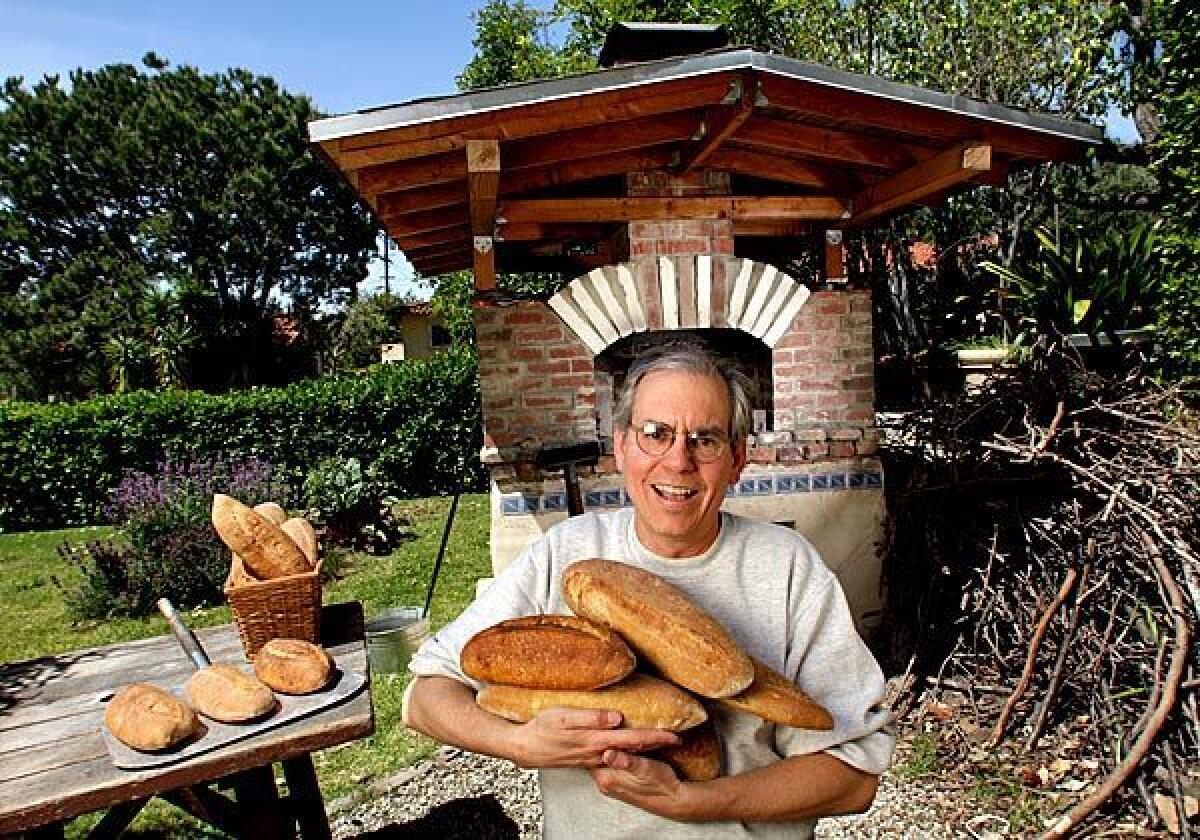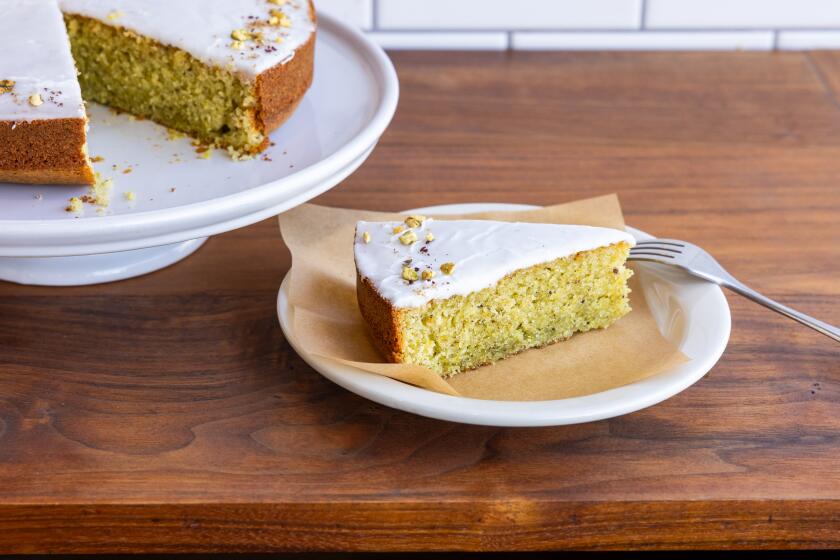The artisan: Bread baker Mark Stambler

- Share via
As Mark Stambler struggles to open a flour-dusted folding table in his Los Feliz home kitchen, it’s pretty clear those charming but space-hungry mint green country cupboards were not the brainchild of this efficiency-driven bread baker. “My wife did all of this,” he says, waving his arms around his head.
Stambler is more of a no-nonsense, get-straight-to-kneading sort of guy. When not working as a fundraising consultant for local arts organizations, he is the devout caretaker of 50 to 60 whole-wheat sourdough loaves that wind up each weekend at the Cheese Store of Silver Lake, Cookbook market in Echo Park and Silver Lake Farms CSA. For Stambler, those yeasty loaves make up for all the unexpected workweek glitches and the 1950s kitchen knickknacks.
“There are only so many things you can control with bread baking, so you have to be precise,” Stambler says as he suddenly slips out the back door to check on the pain Pagnol in his handmade brick oven. “The temperature of the oven, the weight of the dough, the time — that’s about it.”
Though Stambler named the football-shaped loaves after the novelist-turned-filmmaker Marcel Pagnol and his 1930s film “The Baker’s Wife,” it wasn’t movies that brought him to bread baking more than 30 years ago, but necessity. “Back then, if you were a vegetarian and suddenly on your own, you’d better learn how to cook,” he recalls of that post-high school moment when he realized that Mom was no longer in the kitchen.
Stambler picked up a copy of Anna Thomas’ then-recently released cookbook “The Vegetarian Epicure” at a Boston bookstore and began experimenting with easy suppers and yeast bread recipes. But when he moved to Southern California to attend the California Institute of the Arts, the baking recipes got lost among the dorm room hot pots and takeout boxes.
Got a great burger recipe? Submit it to the L.A. Times’ first-ever Battle of the Burgers.
In the decades that followed, Stambler pulled out his pizza stone to make the occasional oven-baked breads after work as a local museum fundraiser, but that was about it in the yeast realm. “Then, suddenly, we were building this oven in our backyard,” he says, shrugging. Stambler and his wife, Suzette, completed the impressive 6-foot-tall oven in 2005. “I’d never done any carpentry or masonry, so I just followed the designs in a book.”
The oven is modeled after one in “The Bread Builders,” a guidebook to hearth oven assembly by revered former Petaluma-based blacksmith and brick oven manufacturer Alan Scott. Stambler chose a standard rectangular-style brick structure atop a concrete base and threw in a pitched wood roof. “It keeps me doing this rain or shine, and it gives Marcel a place to sit,” he says, referring to the family cat, who is sunning on the brick patio nearby.
Stambler has had the help of a more kitchen-friendly apprentice on Fridays, ever since he began dropping off two dozen loaves each weekend at the Cheese Store of Silverlake last year. “I feel it’s my duty to share what I know in bread baking,” he says, adding that the extra pair of hands in his small kitchen comes in handy.
Nearby, apprentice Charlotte Stone, a shoe designer, scans an Excel spreadsheet listing precise ingredient measurements for the sourdough pain au levain and rustic rye bread that Stambler recently added to his lineup. She had been instructed to arrive promptly at 9 a.m., about the time the oven temperature had dropped from a scorching 1,400 degrees to a more bread-appropriate 450. “We all learn to bake bread from someone else,” says Stambler, thrusting a digital thermometer into the oven.
Stambler became an unofficial master boulanger by studying the techniques of Gérard Rubaud, a revered French baker living in Vermont. “I started by increasing the hydration level in the dough as he does,” recalls Stambler. The process requires several days of coordinating dough “builds” (various stages of adding more flour and allowing the dough to rise).
Along that path to crusty perfection, Stambler gave up his vigorous hand-kneading technique in favor of delicately folding the moist dough only twice (he stretches it lengthwise, then delicately folds the edges back toward the center). He makes the loaves with a mix of white flour topped off with whole wheat that he grinds by hand “for maximum flavor.” But Stambler considers swapping commercial yeast for homemade wild yeast starter his true turning point. “It was truly a revelation, the aromas, the flavors,” he says, opening a Tupperware container filled with the starter for Stone to smell.
By lunchtime, Stambler and Stone have baked a dozen football-shaped sourdough bâtards while the next day’s dough rests in a dedicated bread refrigerator. “Let’s be ready to spring into action in five minutes!” Stambler suddenly announces as he bounces about the kitchen.
Stone begins cutting off small chunks of dough, then shapes each into a loose ball. After a brief rest on the folding table, each ball is then flattened into a disc. Stambler demonstrates how to fold the disc in half like a calzone, firmly close the edges and then shape it into a chubby bâtard. Stambler and Stone rest each oblong round among the accordion-like folds of a couche, the stiff canvas cloths that French bakers use to help absorb moisture in order to develop a crispy crust (the rye loaves are already nestled in couche-lined round bread baskets).
Once all the loaves are resting in the refrigerator, Stambler surveys his flour-dusted kitchen. “The agreement that I have with my wife is that the kitchen cannot look like there has been any bread baking going on when she gets home,” he says.
He glances at the clock and decides there is still plenty of time to clean up. Right now he has stories to share with Stone about that summer trip to Vermont last year when he purchased his mentor Rubaud’s bread at the local farmers market. “I wanted to see if mine matched up to his,” he says with a sly grin.
“It does.”
Mark Stambler’s sourdough and rye loaves are available at the Cheese Store of Silverlake (Friday through Sunday), 3926 W. Sunset Blvd., Los Angeles, (323) 644-7511, https://www.cheesestoresl.com; the sourdough is also available through Silver Lake Farms CSA (by subscription, Fridays only), https://www.silverlakefarms.com; and the rye is available at Cookbook Los Angeles (Sundays only), 1549 Echo Park Ave., Los Angeles, (213) 250-1900, https://www.cookbookla.com.
More to Read
Eat your way across L.A.
Get our weekly Tasting Notes newsletter for reviews, news and more.
You may occasionally receive promotional content from the Los Angeles Times.










